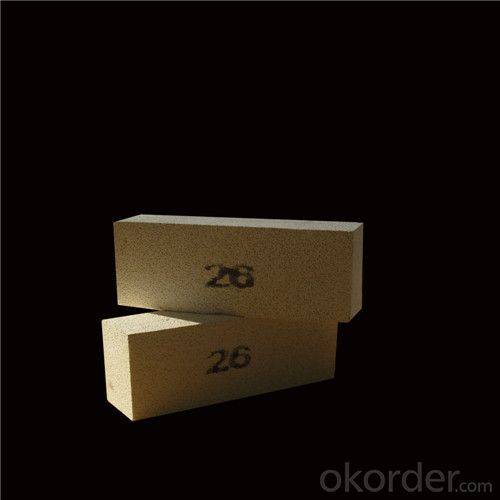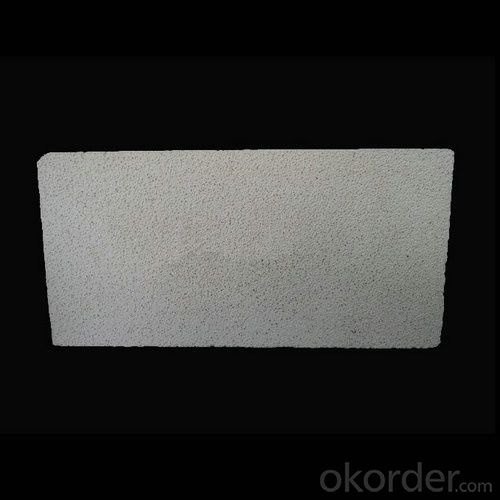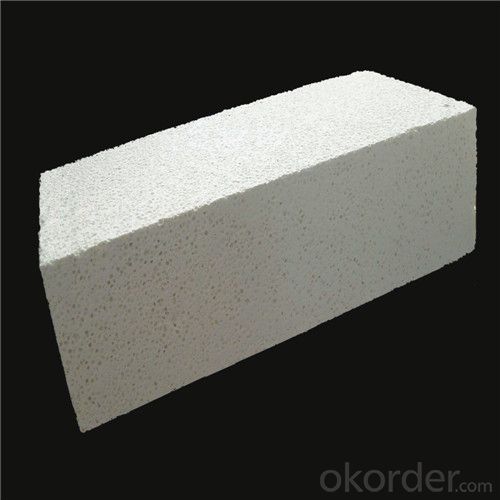Insulating Fire Brick (IFB) in GJM 23, 26, 30 Brands
- Loading Port:
- Shanghai
- Payment Terms:
- TT OR LC
- Min Order Qty:
- 100 pc
- Supply Capability:
- 2000000 pc/month
OKorder Service Pledge
OKorder Financial Service
You Might Also Like
General Information of Insulating Firebricks
CMAX insulating firebricks are classified under temperature between 1300℃ to 1700℃, manufactured from high purity alumina clay.
Image of Insulating Firebricks



Technical Data of Insulating Firebricks

Feature of Insulating Firebricks
Light weight and low thermal conductivity
Low heat storage
Low iron and impurities
High thermal shock resistance
Application of Insulating Firebricks
CMAX insulating firebricks can be used as a hot face lining directly exposed to the heat or as a backup insulation layer in iron and steel mills, non-ferrous foundries, petrochemical, ceramic, glass.
Why Choose Us
l We are a government owned company with ISO certificate.
l We are listed in Global Fortune 500 with D & B report.
l We have more than 11 refractory production facilities and bases across China. We have a wide products range, such as ceramic fiber products (ceramic fiber blanket, module, board, paper, bulk), ceramic fiber textile (ceramic fiber rope, cloth, tape, yarn) etc, refractory brick (fireclay brick, high alumina brick, silica brick, magnesia brick etc), monolithic refractory materials, insulating fire brick, calcium silicate board, mica sheet, steel fiber. You can find various products here, and we can combine the light weight ceramic fiber products with the heavy weight refractory brick in one container delivery, then save the sea freight for you.
l We have strict materials selecting system and quality control system. We have the ability to take responsibility for your orders and product quality.
FAQ
Q1: How do you control the products quality?
A1: With strict quality control system throughout the materials selection and production process, our refractory and ceramic fiber products quality is effectively controlled to meet customer requirements.
From the raw materials selecting, our quality control begin. The quality certificates of raw materials are required and each batch will be tested before using. During production, the quality control are conducted by workers and then each piece will be sorted and examined by quality supervis
Q2: What`s the lead time for my order?
A2: It depends on customers’ requirements and our production schedule. And usually we need 30-60 days for refractory bricks,10-25 days for unshaped refractory materials and 10-20 days for ceramic fiber blankets.
Q3: Can you offer Door-to-Door delivery?
A3: Yes, but only for some countries such us U.S., UAE, Saudi Arabia, Iran, and Russia, etc.
Q4: What is the minimum quantity?
A4: There is no minimum order quantity. Depending on the item and processing, there may be a minimum production required, however we can offer a quotation based only on the quantity you need.
Q5: Can you give me a brief introduction of the application of your products?
A5: CNBM (China National Building Material) core refractory business comprises the production, sale and installation of high-grade refractory products, the development and implementation of customized system solutions as well as rendering outstanding services for the key industries in Glass, Iron& Steel, Petrochemical, Cement, Ceramic and Nonferrous Metals.
- Q:What is the recommended method for installing insulating fire bricks?
- The recommended method for installing insulating fire bricks involves several steps to ensure proper insulation and structural integrity. Here is a step-by-step guide: 1. Prepare the surface: Make sure the surface where the insulating fire bricks will be installed is clean and free from debris. Remove any loose or damaged bricks from the area. 2. Measure and plan: Measure the area where the bricks will be installed and plan the layout accordingly. Take into consideration any openings or corners that may require special cutting or shaping of the bricks. 3. Cut the bricks: Use a diamond blade saw or a masonry saw to cut the insulating fire bricks to the desired size and shape. Wear appropriate protective gear, such as safety goggles and a dust mask, when cutting the bricks. 4. Apply adhesive: Apply a thin layer of refractory adhesive or mortar to the surface where the first brick will be placed. Spread the adhesive evenly using a trowel or a notched trowel. 5. Place the bricks: Carefully place the first brick onto the adhesive, pressing it firmly into place. Ensure that it is level and aligned with the adjacent bricks. Repeat this step for the remaining bricks, leaving a small gap between each brick for expansion. 6. Fill the gaps: Fill the gaps between the bricks with refractory mortar, using a trowel or a grout bag. Press the mortar firmly into the gaps to ensure a tight seal. 7. Allow for curing: Let the adhesive and mortar cure for the recommended time, usually 24 to 48 hours. This will ensure that the bricks are securely bonded and ready for use. 8. Test and insulate: After the curing period, test the installation by gently tapping the bricks to check for stability. Once confirmed, you can proceed with insulating the surrounding area if required, following the manufacturer's instructions. Remember to always follow the specific instructions provided by the manufacturer of the insulating fire bricks and any adhesive or mortar being used. Additionally, it is advisable to consult with a professional or experienced installer if you are unsure about any step of the installation process.
- Q:Can insulating fire bricks be used for insulation in heat recovery systems?
- Yes, insulating fire bricks can be used for insulation in heat recovery systems. These bricks have high thermal resistance, low thermal conductivity, and can withstand high temperatures, making them suitable for insulating and retaining heat in heat recovery systems.
- Q:Are insulating fire bricks suitable for use in the construction of incinerators?
- Insulating fire bricks prove to be a suitable option for constructing incinerators. They are specifically designed to endure high temperatures and possess exceptional insulation properties. Incinerators operate at extremely high temperatures, often surpassing 1000 degrees Celsius, and require materials that can withstand such intense conditions without cracking or deteriorating. Made from lightweight refractory materials like ceramic fibers or lightweight aggregates, insulating fire bricks possess low thermal conductivity. Consequently, they effectively insulate the incinerator, preventing heat escape and maximizing energy efficiency. Moreover, the insulation properties of these bricks aid in maintaining a consistent temperature inside the incinerator, which is crucial for proper combustion and waste disposal. Furthermore, insulating fire bricks exhibit remarkable resistance to thermal shock, enabling them to withstand repeated cycles of heating and cooling without sustaining damage. This attribute is particularly vital in incinerators, where the temperature can rapidly fluctuate during the burning process. The bricks' capacity to endure thermal shock guarantees their durability and longevity in this high-temperature environment. Apart from their insulation and thermal shock resistance, insulating fire bricks offer additional advantages for incinerator construction. They possess a lightweight nature, facilitating easier handling and transportation during the construction phase. Furthermore, they can be readily cut or shaped to fit specific designs or requirements, allowing for flexibility in incinerator construction. In conclusion, insulating fire bricks stand as an ideal choice for incinerator construction due to their resistance to high temperatures, insulation properties, thermal shock resistance, durability, and ease of use. They provide a reliable and efficient solution for containing and maintaining the intense heat generated in incinerators, ensuring the safe and effective disposal of waste.
- Q:Are insulating fire bricks resistant to high-velocity gases?
- Yes, insulating fire bricks are generally resistant to high-velocity gases. Insulating fire bricks are designed to have high thermal resistance and low thermal conductivity, which makes them ideal for applications where they are exposed to high temperatures and gases. They are able to withstand the impact and velocity of gases without getting damaged or compromised. Insulating fire bricks are commonly used in industrial furnaces, kilns, and other high-temperature environments where they need to provide insulation and protection against high-velocity gases.
- Q:Can insulating fire bricks be used in the construction of furnaces?
- Yes, insulating fire bricks can be used in the construction of furnaces. Insulating fire bricks are specially designed bricks that have high insulating properties, allowing them to withstand high temperatures while minimizing heat loss. These bricks are made from lightweight materials such as clay, silica, and alumina. They have a low thermal conductivity, which means they can effectively maintain heat within the furnace while preventing the outer surface from becoming too hot. This makes them ideal for lining the walls, roof, and floor of furnaces, helping to increase energy efficiency and reduce fuel consumption. Additionally, insulating fire bricks are resistant to thermal shock, making them highly durable and long-lasting in the harsh conditions of a furnace. Overall, insulating fire bricks are a popular choice for furnace construction due to their excellent insulating properties and ability to withstand high temperatures.
- Q:Can insulating fire bricks be used as a thermal barrier?
- Indeed, insulating fire bricks have the potential to function as a thermal barrier. Specifically engineered with low thermal conductivity, these bricks are adept at reducing heat transfer. Consequently, they are an optimal selection for thermal insulation purposes. Their widespread usage is observed in industries that entail elevated temperatures, including furnaces, kilns, and other heat-intensive procedures. By employing insulating fire bricks, heat loss can be minimized, steady temperatures can be maintained, and energy efficiency can be enhanced. Furthermore, their lightweight composition facilitates effortless handling and installation, thereby augmenting their suitability as a thermal barrier.
- Q:Are insulating fire bricks suitable for use in coke ovens?
- Yes, insulating fire bricks are suitable for use in coke ovens. These bricks are designed to withstand high temperatures and provide excellent insulation properties, making them ideal for use in coke ovens where extreme heat is generated during the coking process. They help to maintain the desired temperature inside the oven and prevent heat loss, resulting in improved energy efficiency and reduced fuel consumption. Additionally, insulating fire bricks have good resistance to chemical reactions and thermal shock, which further enhances their suitability for use in coke ovens.
- Q:Can insulating fire bricks be used in high-temperature filters?
- Yes, insulating fire bricks can be used in high-temperature filters. These bricks are designed to withstand extreme temperatures and provide excellent insulation. They can effectively trap and filter out impurities in high-temperature environments, making them suitable for use in high-temperature filters.
- Q:Can insulating fire bricks be used in refractory castings?
- Yes, insulating fire bricks can be used in refractory castings. Insulating fire bricks are lightweight and have high insulating properties, making them suitable for applications that require thermal insulation. This includes refractory castings, which are used to create linings in furnaces, kilns, and other high-temperature equipment. The insulating fire bricks can be used as a layer or as a part of the refractory casting mix to provide thermal insulation and reduce heat loss. Additionally, their low thermal conductivity helps in minimizing energy consumption and maintaining high temperatures within the casting.
- Q:Can insulating fire bricks be used as insulation in walls and roofs?
- Yes, insulating fire bricks can be used as insulation in walls and roofs. They have excellent thermal insulation properties, high heat resistance, and are specifically designed for use in high-temperature environments.
1. Manufacturer Overview |
|
|---|---|
| Location | |
| Year Established | |
| Annual Output Value | |
| Main Markets | |
| Company Certifications | |
2. Manufacturer Certificates |
|
|---|---|
| a) Certification Name | |
| Range | |
| Reference | |
| Validity Period | |
3. Manufacturer Capability |
|
|---|---|
| a)Trade Capacity | |
| Nearest Port | |
| Export Percentage | |
| No.of Employees in Trade Department | |
| Language Spoken: | |
| b)Factory Information | |
| Factory Size: | |
| No. of Production Lines | |
| Contract Manufacturing | |
| Product Price Range | |
Send your message to us
Insulating Fire Brick (IFB) in GJM 23, 26, 30 Brands
- Loading Port:
- Shanghai
- Payment Terms:
- TT OR LC
- Min Order Qty:
- 100 pc
- Supply Capability:
- 2000000 pc/month
OKorder Service Pledge
OKorder Financial Service
Similar products
New products
Hot products
Related keywords






























